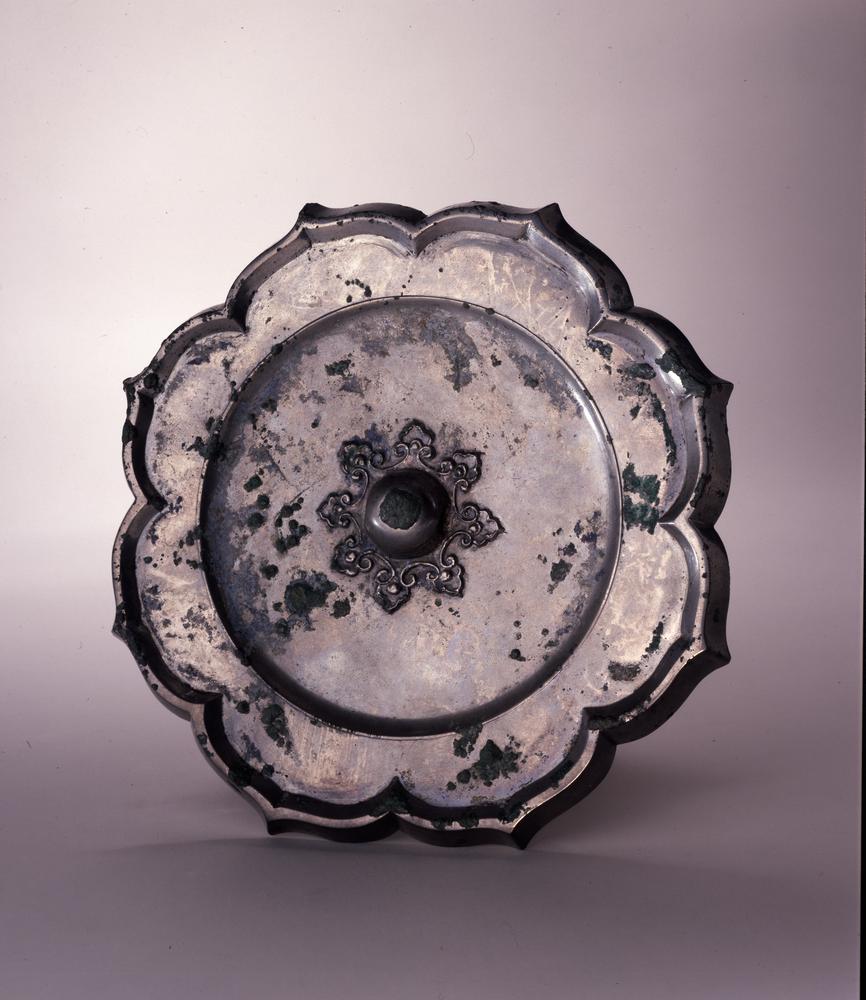Period:Tang dynasty Production date:851-950 (circa)
Materials:hemp, 麻 (Chinese),
Technique:painted
Subjects:bodhisattva canopy,flower vessel 菩薩 (Chinese) 華蓋 (Chinese) 花 (Chinese) 器皿 (Chinese)
Dimensions:Height: 130 centimetres Width: 50 centimetres
Description:
Painting of Bodhisattva Avalokiteśvara holding a vase and a flower, standing under a jewelled, floral canopy and with flowers in the background. Faded inscription in cartouche. Ink and colour on hemp.
IMG
![图片[1]-painting; banner; 繪畫(Chinese); 幡(Chinese) BM-1919-0101-0.201-China Archive](https://chinaarchive.net/Tang dynasty/Paintings/mid_00000438_001.jpg)
![图片[2]-painting; banner; 繪畫(Chinese); 幡(Chinese) BM-1919-0101-0.201-China Archive](https://chinaarchive.net/Tang dynasty/Paintings/mid_00000439_001.jpg)
![图片[3]-painting; banner; 繪畫(Chinese); 幡(Chinese) BM-1919-0101-0.201-China Archive](https://chinaarchive.net/Tang dynasty/Paintings/mid_Stein_201_finished.jpg)
![图片[4]-painting; banner; 繪畫(Chinese); 幡(Chinese) BM-1919-0101-0.201-China Archive](https://chinaarchive.net/Tang dynasty/Paintings/mid_stitch_1_3.jpg)
![图片[5]-painting; banner; 繪畫(Chinese); 幡(Chinese) BM-1919-0101-0.201-China Archive](https://chinaarchive.net/Tang dynasty/Paintings/mid_stitch_5_6.jpg)
![图片[6]-painting; banner; 繪畫(Chinese); 幡(Chinese) BM-1919-0101-0.201-China Archive](https://chinaarchive.net/Tang dynasty/Paintings/mid_Stein_201_1.jpg)
![图片[7]-painting; banner; 繪畫(Chinese); 幡(Chinese) BM-1919-0101-0.201-China Archive](https://chinaarchive.net/Tang dynasty/Paintings/mid_Stein_201_2.jpg)
![图片[8]-painting; banner; 繪畫(Chinese); 幡(Chinese) BM-1919-0101-0.201-China Archive](https://chinaarchive.net/Tang dynasty/Paintings/mid_Stein_201_3.jpg)
![图片[9]-painting; banner; 繪畫(Chinese); 幡(Chinese) BM-1919-0101-0.201-China Archive](https://chinaarchive.net/Tang dynasty/Paintings/mid_Stein_201_4.jpg)
![图片[10]-painting; banner; 繪畫(Chinese); 幡(Chinese) BM-1919-0101-0.201-China Archive](https://chinaarchive.net/Tang dynasty/Paintings/mid_Stein_201_5.jpg)
![图片[11]-painting; banner; 繪畫(Chinese); 幡(Chinese) BM-1919-0101-0.201-China Archive](https://chinaarchive.net/Tang dynasty/Paintings/mid_Stein_201_6.jpg)
Comments:EnglishFrom Whitfield 1983:In almost every way this banner presents a complete contrast with the painting of the preceding plate. The delicate fine are replaced by bold silhouettes, with flowers and twisting scarves filling the spaces round the figure. The figure itself is amply draped, and conventional schematic shading replaces flesh tones in the few parts where the arms of face are exposed. Details such as the delineation of the facial features suggest a date at the end of the ninth century.The actual material, as well as the execution, is coarser than that of Pl. 38, but the natural colour of the hemp cloth in the broad border shows up the treatment of the main surface before the figure was painted; and the original hanging loops, through which a stick could have passed, are clearly visible at the top. Most of the larger paintings on hemp cloth, if not narrow banners with a triangular headpiece, were hung in this way, and so must have been the paintings on silk as well.The inscription reads 南無延壽命救苦觀世音菩薩, “The Bodhisattva Guanshiyin who prolongs life and rescues from trouble”. The description matches the compassionate appearance of the Bodhisattva and both are evidence of his widespread popularity in the late Tang and Five Dynasties. ChineseFrom Whitfield 1983:此圖的幡,各個方面的表現都與上一圖形成對照。上圖的線描纤细優美,而此畫的線描則粗而有力,像周圍的空間也被花和彎曲的天衣填滿。觀音全身裹著衣服,手臂和臉部露出的部分沒有淡淡的肉色,而被圖式化的暈染所代替。從臉部等細部的表現看,可设想为9世紀末期的作品。無論是麻布的質地,還是繪畫的表現,明顯比上一圖粗糙。但是,寬幅的布邊部分可見自然的麻布顔色,而中心部位的麻布,在描像之前漂過白。另外,上部還保留着當時的兩個吊環,原來是用棒穿過吊環用以懸挂幡的。與三角形幡頭的窄幅幡不同,大幅的麻繪,大多都用吊環懸挂,絹繪可能也是一樣。長方形题笺中寫着“南無延壽命救苦觀世音菩薩”,畫面也著力反映出了菩薩的慈悲。這兩點都可證明觀音在唐末五代時期的廣泛流行。
Materials:hemp, 麻 (Chinese),
Technique:painted
Subjects:bodhisattva canopy,flower vessel 菩薩 (Chinese) 華蓋 (Chinese) 花 (Chinese) 器皿 (Chinese)
Dimensions:Height: 130 centimetres Width: 50 centimetres
Description:
Painting of Bodhisattva Avalokiteśvara holding a vase and a flower, standing under a jewelled, floral canopy and with flowers in the background. Faded inscription in cartouche. Ink and colour on hemp.
IMG
![图片[1]-painting; banner; 繪畫(Chinese); 幡(Chinese) BM-1919-0101-0.201-China Archive](https://chinaarchive.net/Tang dynasty/Paintings/mid_00000438_001.jpg)
![图片[2]-painting; banner; 繪畫(Chinese); 幡(Chinese) BM-1919-0101-0.201-China Archive](https://chinaarchive.net/Tang dynasty/Paintings/mid_00000439_001.jpg)
![图片[3]-painting; banner; 繪畫(Chinese); 幡(Chinese) BM-1919-0101-0.201-China Archive](https://chinaarchive.net/Tang dynasty/Paintings/mid_Stein_201_finished.jpg)
![图片[4]-painting; banner; 繪畫(Chinese); 幡(Chinese) BM-1919-0101-0.201-China Archive](https://chinaarchive.net/Tang dynasty/Paintings/mid_stitch_1_3.jpg)
![图片[5]-painting; banner; 繪畫(Chinese); 幡(Chinese) BM-1919-0101-0.201-China Archive](https://chinaarchive.net/Tang dynasty/Paintings/mid_stitch_5_6.jpg)
![图片[6]-painting; banner; 繪畫(Chinese); 幡(Chinese) BM-1919-0101-0.201-China Archive](https://chinaarchive.net/Tang dynasty/Paintings/mid_Stein_201_1.jpg)
![图片[7]-painting; banner; 繪畫(Chinese); 幡(Chinese) BM-1919-0101-0.201-China Archive](https://chinaarchive.net/Tang dynasty/Paintings/mid_Stein_201_2.jpg)
![图片[8]-painting; banner; 繪畫(Chinese); 幡(Chinese) BM-1919-0101-0.201-China Archive](https://chinaarchive.net/Tang dynasty/Paintings/mid_Stein_201_3.jpg)
![图片[9]-painting; banner; 繪畫(Chinese); 幡(Chinese) BM-1919-0101-0.201-China Archive](https://chinaarchive.net/Tang dynasty/Paintings/mid_Stein_201_4.jpg)
![图片[10]-painting; banner; 繪畫(Chinese); 幡(Chinese) BM-1919-0101-0.201-China Archive](https://chinaarchive.net/Tang dynasty/Paintings/mid_Stein_201_5.jpg)
![图片[11]-painting; banner; 繪畫(Chinese); 幡(Chinese) BM-1919-0101-0.201-China Archive](https://chinaarchive.net/Tang dynasty/Paintings/mid_Stein_201_6.jpg)
Comments:EnglishFrom Whitfield 1983:In almost every way this banner presents a complete contrast with the painting of the preceding plate. The delicate fine are replaced by bold silhouettes, with flowers and twisting scarves filling the spaces round the figure. The figure itself is amply draped, and conventional schematic shading replaces flesh tones in the few parts where the arms of face are exposed. Details such as the delineation of the facial features suggest a date at the end of the ninth century.The actual material, as well as the execution, is coarser than that of Pl. 38, but the natural colour of the hemp cloth in the broad border shows up the treatment of the main surface before the figure was painted; and the original hanging loops, through which a stick could have passed, are clearly visible at the top. Most of the larger paintings on hemp cloth, if not narrow banners with a triangular headpiece, were hung in this way, and so must have been the paintings on silk as well.The inscription reads 南無延壽命救苦觀世音菩薩, “The Bodhisattva Guanshiyin who prolongs life and rescues from trouble”. The description matches the compassionate appearance of the Bodhisattva and both are evidence of his widespread popularity in the late Tang and Five Dynasties. ChineseFrom Whitfield 1983:此圖的幡,各個方面的表現都與上一圖形成對照。上圖的線描纤细優美,而此畫的線描則粗而有力,像周圍的空間也被花和彎曲的天衣填滿。觀音全身裹著衣服,手臂和臉部露出的部分沒有淡淡的肉色,而被圖式化的暈染所代替。從臉部等細部的表現看,可设想为9世紀末期的作品。無論是麻布的質地,還是繪畫的表現,明顯比上一圖粗糙。但是,寬幅的布邊部分可見自然的麻布顔色,而中心部位的麻布,在描像之前漂過白。另外,上部還保留着當時的兩個吊環,原來是用棒穿過吊環用以懸挂幡的。與三角形幡頭的窄幅幡不同,大幅的麻繪,大多都用吊環懸挂,絹繪可能也是一樣。長方形题笺中寫着“南無延壽命救苦觀世音菩薩”,畫面也著力反映出了菩薩的慈悲。這兩點都可證明觀音在唐末五代時期的廣泛流行。
© Copyright
The copyright of the article belongs to the author, please keep the original link for reprinting.
THE END
![[Qing Dynasty] British female painter—Elizabeth Keith, using woodblock prints to record China from the late Qing Dynasty to the early Republic of China—1915-China Archive](https://chinaarchive.net/wp-content/uploads/2022/11/image-191x300.png)




